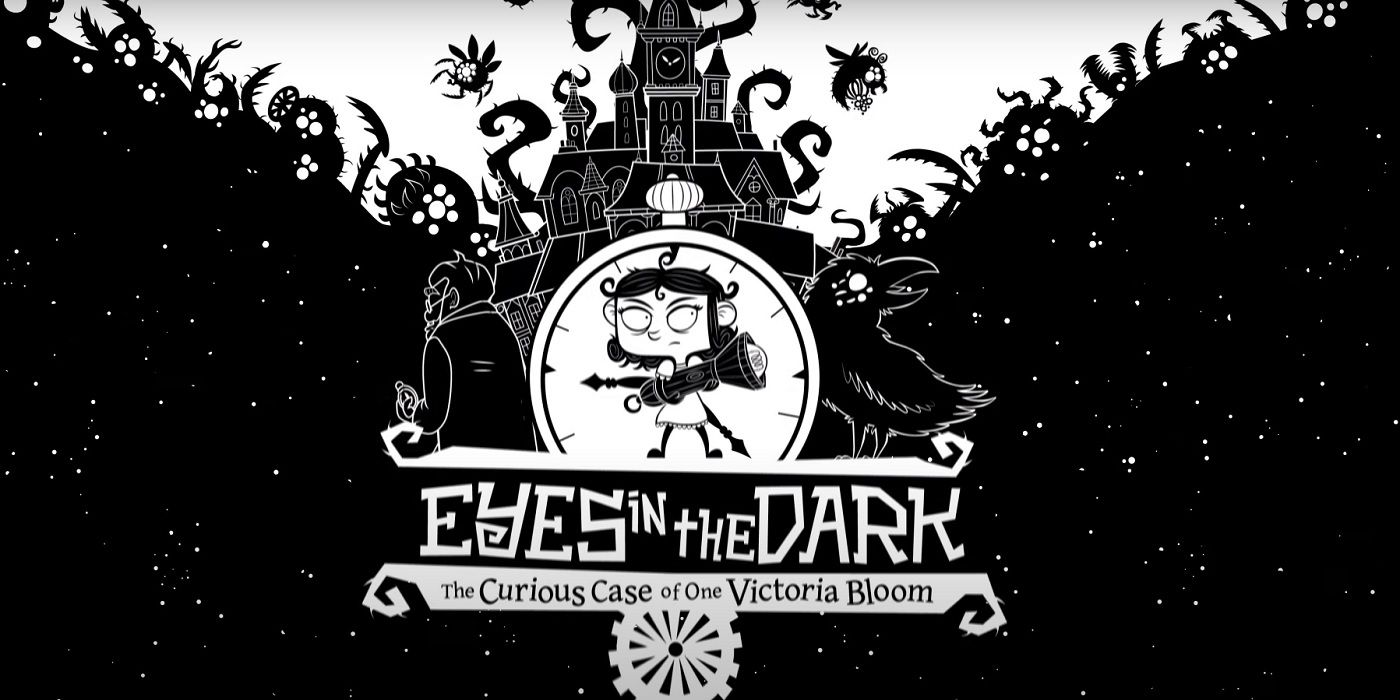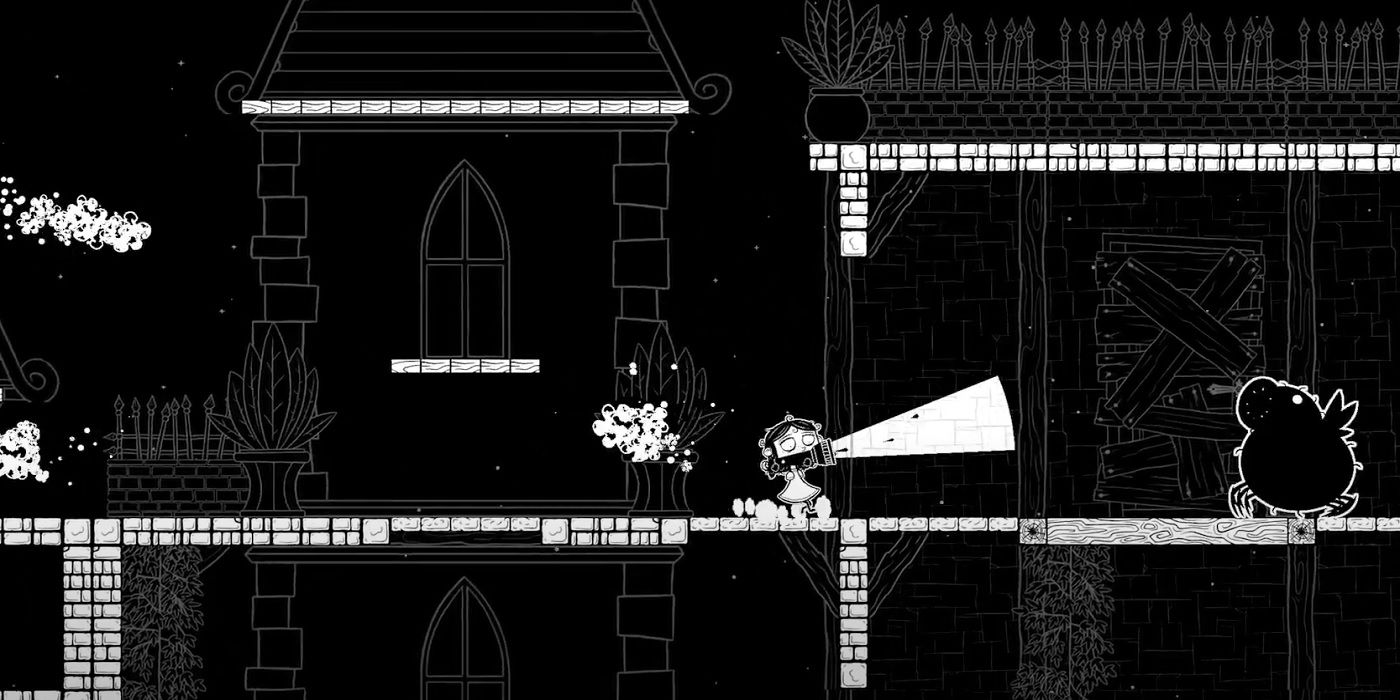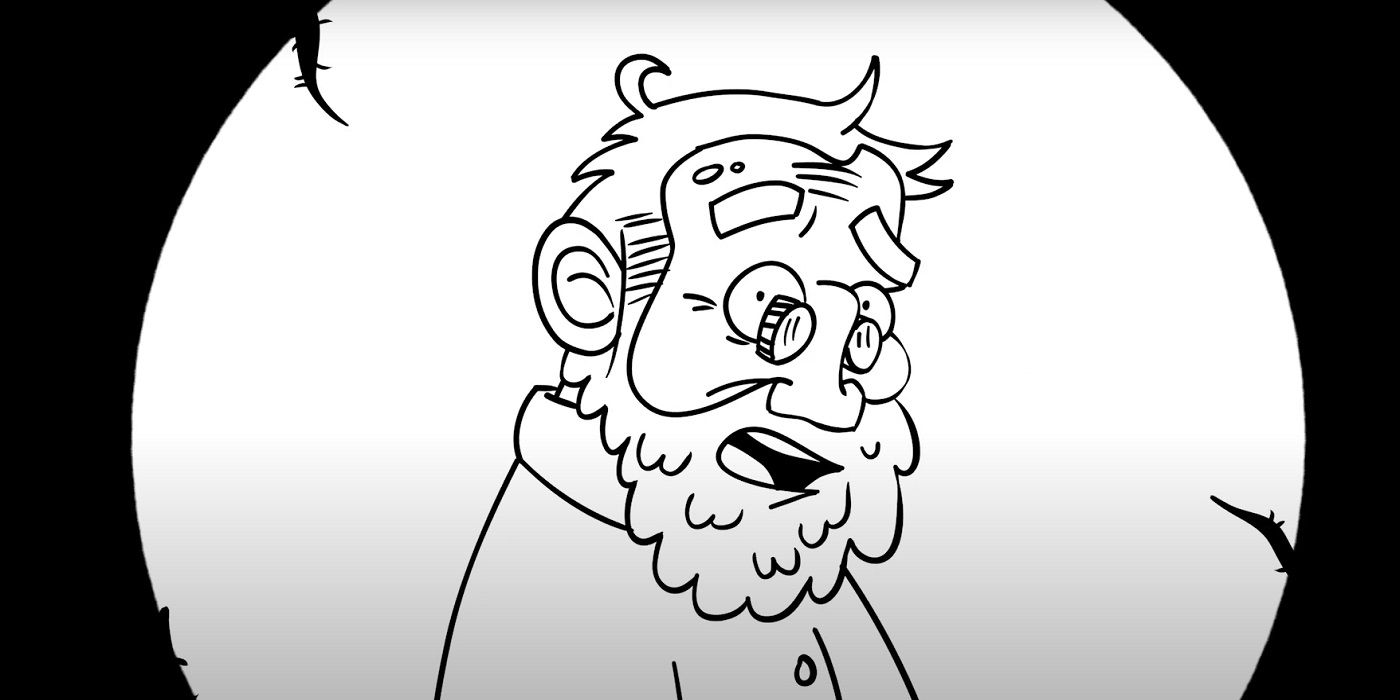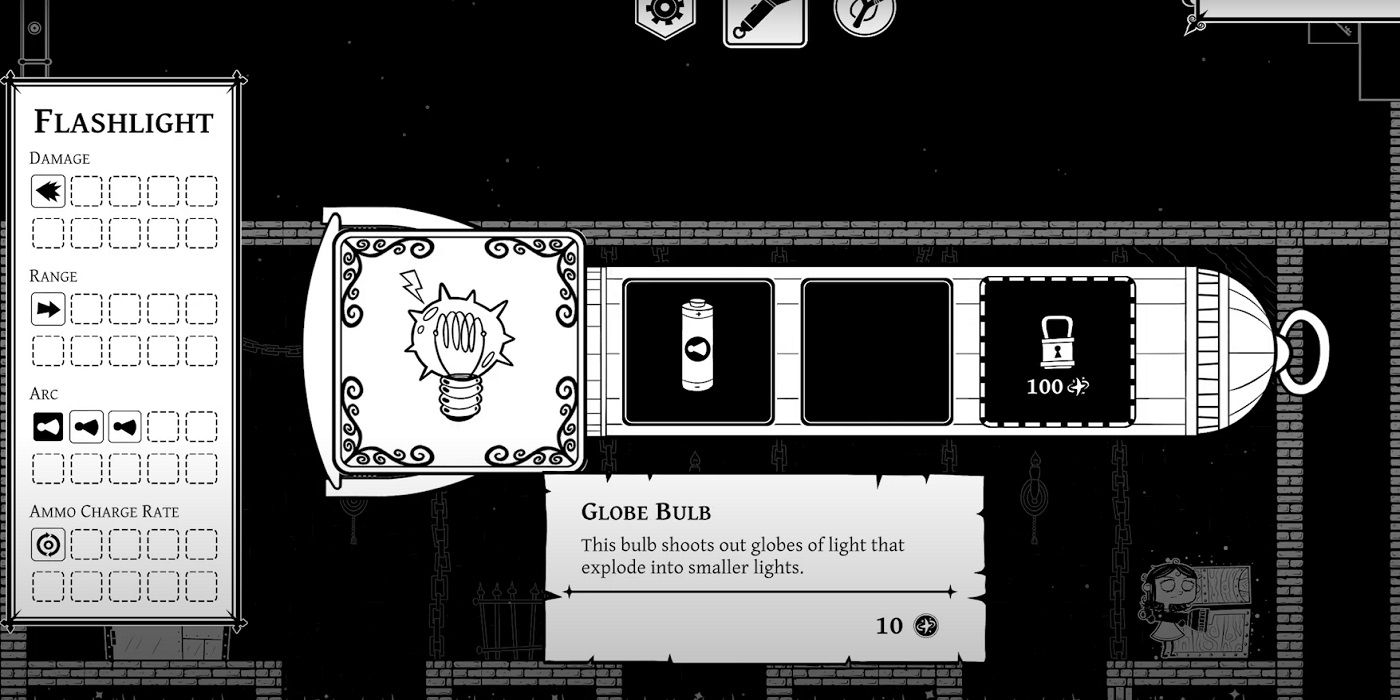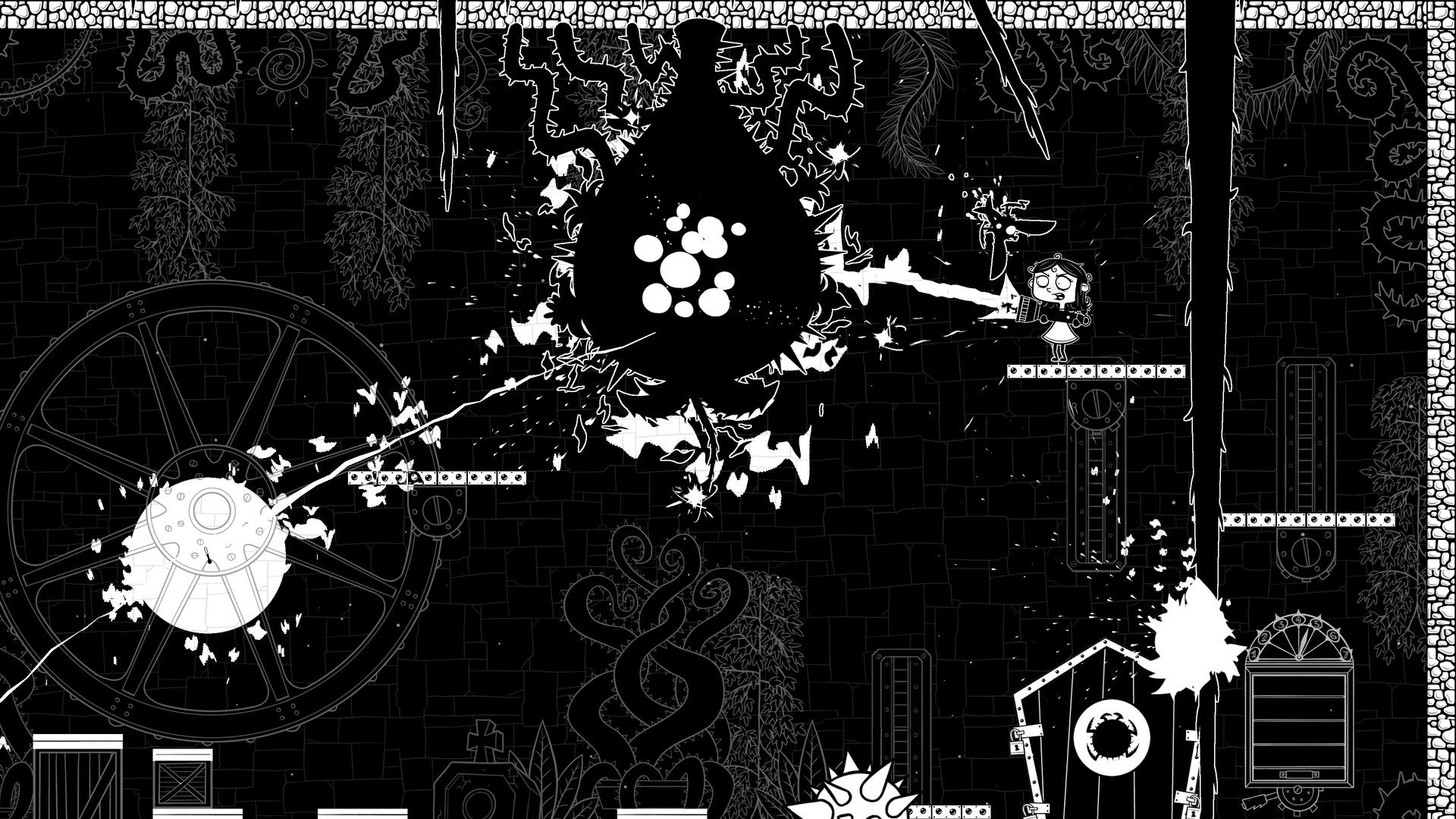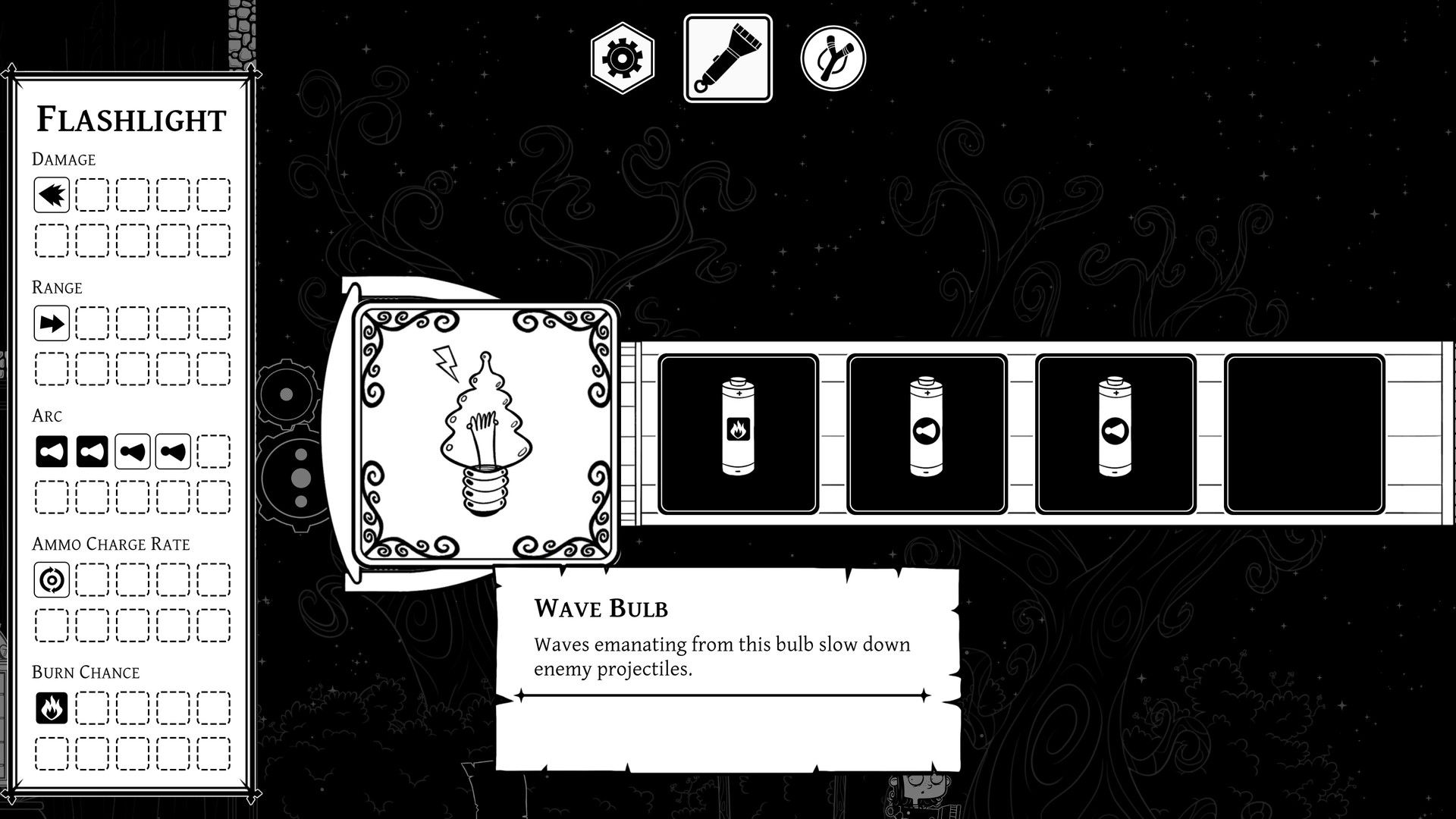Players will soon be able to battle the darkness in Eyes in the Dark: The Curious Case of One Victoria Bloom, a recently announced indie game developed by Under The Stairs and published by Gearbox Publishing. Players will take on the role of Victoria, a young girl attempting to locate her grandfather, and embark on a perilous adventure through a large family mansion shrouded in darkness. The art style of Eyes in the Dark is similar to the Don't Starve series, combining 2D illustrations with black and white colors for a unique fantasy adventure.
Eyes in the Dark: The Curious Case of One Victoria Bloom turns a player's light source into a weapon as they explore the numerous rooms of their family's mansion. Using a flashlight and a slingshot, players must battle silhouetted monsters made of darkness, locate hidden secrets, and beware of the eyes always watching them. Additionally, players can upgrade their flashlight's bulbs to create new effects and use numerous light-themed projectiles in the slingshot to deal light-based damage to enemies. The unique combat system will likely appeal to fans of Hollow Knight for its fast-paced action and narratively-important upgrades.
However, Eyes in the Dark: The Curious Case of One Victoria Bloom may be a particularly good choice for gamers who enjoy unique art direction in games. Using only black and white to create the game's environments, and relying on a mixture of interesting character designs and lineweight, Eyes in the Dark offers players a whimsical world to explore. To help break down design choices and explain the art direction for Eyes in the Dark: The Curious Case of One Victoria Bloom, Under The Stairs Director Vladimir Bogdanic and Game Designer Filip Neduk have sat down with Screen Rant, offering new details about the PC game ahead of it's July 14, 2022 release.
What was your inspiration for such a unique game? How did you get started designing Victoria, and what were the decisions you made early in development to create that character?
Filip Neduk: Basically, the game started off as a game jam. It was a five-day game jam, but I wasn't involved then. I was on the other team, and we won the award for best art. Then we got together later on, and when we decided to make the game, he put me on and said I can do whatever I want.
But the concept they had was the black-and-white game. The only thing the game jam game had was the black-and-white color and the little girl as a main character.
That's kind of when we met for the first time. I used to do board games, and I still kind of do. I'm a board game designer first, and I dabble in art. I'm really not into it too much; I'm more interested in game design. He wanted that an artist, and I said, "But I'm also game designer," so he kept me on.
I started drawing, and I had these two little ideas: the black-and-white and the girl. "What can I mix up with this?" There was the idea of this mansion, and her coming along into this darkness, because you had the light with the dark already. That's kind of the origin of that. The first concept art was actually Victoria herself holding the flashlight, cutting out the dark with her light. And actually, that concept art is the way the game looks like now - from the first time. It wasn't later on. Everybody really liked that piece of concept art, and we started building up from there.
That premise was just so strong that it really followed through.
Filip Neduk: When I drew it for the first time, I really liked this idea of this girl with a big head and a giant flashlight. The idea that you're fighting this crazy darkness with a household item is really, really amazing to me.
It elicits such a primal response. Who wasn't at that age afraid of the dark? You guys have made tangible monsters of the things we were all nervous about.
Filip Neduk: I liked the flashback as a weapon, because everybody who's ever held a flashlight as a kid used it like a lightsaber. Everybody! Instinctively it's a weapon, and it's a weapon against the dark, because you want to see where you want to go. So, that also clicked together. You have this kid who has this huge thing that's gonna keep her safe.
My initial response when I saw the trailer, and then when I was looking at some of the concept art was, is this is a tangible remake of, "I need to get a drink of water in the middle of the night, but there might be something under the bed." What were the design processes you took on to create the creatures that are made of darkness? They almost look cuddly, and then you look at them more closely and are like, "That'll eat you."
Filip Neduk: That's an interesting question, because we're a really small studio. When we started, there were three of us, and none of us know how to animate anything. When I was designing the monters, I wanted to make them simple, because the whole graphic is just a silhouette of darkness. The silhouette is what makes them different, and they have these googly eyes, which give them this otherworldly feel. It's really a cheap and effective way to make cosmic horror, because they are scary, but they're also cute.
Basically, we kept these two elements. We kept this silhouette that can be a lot of legs or a lot of hair coming out, and these eyes, that just kind of stand there and look at you. We didn't have great animators, because when you animate a silhouette, you don't have something that's in front or in the back. It's just animated. And we can do a lot with a little; it's a cheap and effective way to do a lot. That's how everything kind of came together.
It does a really good job of working with the tone because you've created the monsters that you would expect a little girl to see. In some of these recent horror games, the monsters are almost too complex for the character, but this is like the perfect kind of evil for some seven-year-old fighting with a flashlight to handle. It creates this very whimsical tone that's very immersive.
Filip Neduk: Yeah, and it's really amazing how far we could go with the concept. silhouette. Because the mansion has nine different zones, and each zone has its own history and its own type of monsters. Basically, we have a boiler room that's full of sea creatures: there's crabs and shrimps and manta-rays. And we have a garden that's full of plant-like creatures. It's all the same silhouette, but you can really tell them apart based on their behavior.
And what's really interesting is their eyes. Eyes are a very big motif in our game; the eyes represent Victoria's eyes in the dark, the monster's eyes, the stars - the stars are a big thing. It's all connected in this kind of cosmic thing. The stars are basically a lot of eyes watching in the dark. The eyes also represent a lot of things; the eyes are the key points, because we really didn't want like a hit point bar above something. When Victoria damages them, their eyes kind of pop out and it's the damage bar.
But the eyes also are the resource, so they are like sparks within the darkness reaching out. You can pull it away from them, and then it's a resource. You kind of buy things with them.
Eyeball currency, I love that. Keeping a game in black-and-white can sometimes be flat, but you guys have created this amazing depth with background designs and line weight. What was the hardest part of working with a black-and-white design?
Filip Neduk: Oh, it was really hard. And I'm actually really glad for this question, because at the beginning, everything was strictly black and white. We made the decision that we were gonna have no grays. No grays, no gradients, nothing - we were going to go above and beyond. We made it like that, and backgrounds really popped out too much. So, we had to make a compromise at some point.
How it works is that the farther things are in the background, the thinner the lines. We actually put grays, but just in the lines. Stuff on the walls has really thin lines, but they're real close to dark. We only put grays in the lines - and that's how we got this illusion of things that are important, that the player interacts with, are white. And then it goes grayer and grayer. You don't see it, but you see it at the same time. When we did that, it was a whole different thing. It really popped out.
Vladimir Bogdanic: We initially had issues with readability; what you can interact with and what you can't interact with. And then as soon as you set those ground rules, [it's better]. If it's a chest and you can open it, then it's predominantly white. If it's just a background element, it doesn't have a white fill or fill of any kind; you can only see the outlines.
It creates an incredibly intricate background. That was one of the very first things that jumped out to me, this refined and beautiful latticework in the background, almost like patterns on the lace. And I was just astounded, because I've never seen anything like that in a black-and-white game before. The paint look is very popular, where things get blurry in the back, but these crisp designs make me hungry to explore the environment. It looks fantastic.
Filip Neduk: Yeah, it was a lot of hard work to get to this point. The concept art kept the whole thing with the darkness, and it's really interesting with how the light works. Basically, the light is just inverted backgrounds. Victoria has a cone of light, and you can actually still see the background, but it's just an inverse. It's a really cheap trick that looks really good.
It works. When you're doing anything traditional, inverting paper that you've done line press on with ink is a super effective way to get consistency. Your designs give off this creepy vibe that reminds me of titles like Nightmare Before Christmas and Series of Unfortunate Events. Were there any books or other outside media that you really looked to when you were creating your designs?
Filip Neduk: Those are the kind of obvious references, especially the Tim Burton stuff. But I really liked Neil Gaiman and his stories. I think that was a big inspiration for everything, especially for the atmosphere and stuff. I don't think we're going too morbid with this, like Tim Burton does. It's more like a kids' detective book horror story.
I appreciate your Neil Gaiman love. What was the process for creating your backgrounds? Not just the line weight, but also choosing the rooms and creating these environments? Some of the areas are not what you would expect to see: the boiler room looks very industrial in the trailer.
Filip Neduk: That all has to do with the story of the game. When we decided to put the game in the mansion, we early on knew we were gonna have nine different zones and were deciding what they're gonna be.
The whole idea is that Victoria's family - this is a little bit of a spoiler - has been fighting the dark for centuries. Her whole family are all scientists, so everything is really based on science, even from Middle Ages to today. I really wanted to show different technologies they used to find the lights.
The boiler is Fiona Bloom's domain, so each family member built one part of the house and it shows their expertise in science. Your grandpa is a scientist, so he has a laboratory. Fiona was an engineer, so she has the steampunk aesthetic. We have the twins, Liz and Eugene, who have the attic. They were explorers, and they bought a lot of stuff, so there's little doodads in the attic. We really wanted the house to tell a story itself, so the house is an extra character in the game.
Vladimir Bogdanic: I think you also were digging out a lot of references for a specific time period where certain things were happening, and then you'd use those photos of old contraptions. Whatever we felt that was relevant to the time period, you found it and made a way to put it in the game.
And that only adds to the immersion and depth of the narrative, so that you are actually in the story and not just interacting with bits of the story.
Filip Neduk: Yeah, I really wanted the level to speak to you.
How did you choose each flashlight effect, and how did you design and create those effects in this environment? Because it looks like we have several different options.
Filip Neduk: When you have a light source as a weapon, you're really limited by the graphics. It can only be a white thing that moves around. I'm really not good at VFX; this is the first time that I did them, so thank you. Our weapons are based on like things that image light. So, the main weapon against the dark is this flashlight, and you can change different types of bulbs. You have an electricity bulb, you have a bubble bulb that shoots little bubbles, and a laser.
But also, she has a slingshot. She has projectiles that she shoots, but we really wanted to have as many light sources as we could. The flashlight is the main weapon, but the slingshot gave us a lot of options. She can shoot matches, flares, and little contraptions that her family built. She has a remote arm that shoots fireworks; we have a cherry bombs. Basically, anything you can think of that has any light source, it's here. We have little fireflies that fly in and damage enemies.
And you kept with the light theme, because it'd be so easy to just give her just some rocks or some easy-to-pocket item. But you've really tied in that secondary weapon to make sure it's cohesive with the rest of the environment.
Filip Neduk: Everything she does has to do with light. You have extra effects like burning, and we call it glimmer. You do extra damage with flashlights. and it enhances the damage. Everything is glare-based; everything is light-based. It was really hard at some points to come up with stuff like that, but you're limited by light.
We've been talking about the atmosphere of the game, and how it's a spooky kid's eye view of monsters in the dark? What types of emotions and reactions are you hoping to elicit from players: are you trying to send them back to where they would have been when they were kids, or put them in the shoes of somebody else who has this very different view?
Filip Neduk: What I hope to do with the game is that, when you see it for the first time, you think of it as a haunted house scenario. But the game really delves into science fiction and cosmic horror a lot. I wanted people to have expectations of one thing, and when they play it [they're surprised].
One of the core mechanics that you will learn early on is time travel. She's stuck in a time loop, trying to find her grandfather across multiple, alternate timelines. That's how we justify the genre, and why the house changes and mixes up all the time; why it's different. She jumps from alternate reality to alternate reality, and each of those realities are contained within the house. She experiences all of her family history in this weird, mixed-up way.
Also, spoiler alert: when she finds her grandpa, then they together discover the family history. And then it goes into weird cosmic themes: "This darkness isn't from here. It's from somewhere beyond."
Vladimir Bogdanic: From my perspective, one thing that I really enjoy here is the whole power fantasy trip. You're expecting it to be a really dark, quirky and disturbing story. But in reality, the longer you play, the more powerful and whimsical the whole thing becomes. The further along you get, it becomes more about being curious, learning more about your family history and about the environment; about the world you inhabit. And that, I think, is a really powerful motif in general.
I think everyone has played numerous games where you start off and don't really know what you're doing. But then if you just keep hammering away at it, you discover more and more things. You learn as your character in the game learns as well. That's also where the narrative of the game comes in; we're trying to sync it up with the player experience, and not just have it be something where you have a lot of exposition or a lot of story that isn't necessarily related to your experience of the game. That's kind of the general idea.
When tapping on the horror genre, where everything is very Five Nights at Freddy's, you get scares, and the lore is kind of blurry. I'm a big fan of using horror to enrich the plot. To me, it sings of that retro early horror era, where things were more about discovering what was going on and less about just being scared. What was the biggest challenge you faced overall in designing eyes in the dark?
Filip Neduk: Actually, most of the kind of design comes from the art itself. A lot of things were kind of based on the black and white colors. It was a big crutch. It wasn't as easy as I'm making it sound, but I think that was the big challenge. This being our first game? That was insane. We had no idea how much work this would be.
For a first-time game, I think it's beautiful. It's definitely one of those that's going to stand out and stay with me personally. What was the most exciting aspect of production for the game?
Vladimir Bogdanic: Working with Gearbox has definitely been a huge highlight. To be honest, before we signed a publishing deal, one of the bigger challenges for us was the overall milestone structure. You're working for months on end, and you're hoping that an event comes along where you have to showcase a demo. You basically have to push these limits on yourself as to when certain things have to be done.
Then once a publisher comes in, then it's milestone, milestone, milestone; deliverable, deliverable deliverable. Suddenly, that gave us a really solid structure to just keep hammering away at it, iterating and making sure that the game is better every month. I think for a studio's first game, that's been a huge boost for us.
We're from Croatia, and the video game scene here isn't that big. If you sometimes want feedback from people, and you want hardcore roguelite fans to check out the game, you won't necessarily get as much good feedback as you can when you're working with a bigger publisher who can support you with usability testing and research. Getting feedback documents every month has really helped us iterate on the whole thing and made the process a lot smoother.
What's your favorite monster? Out of all the creatures you've made for this game, which one is your pocket pet?
Filip Neduk: That's really hard. There's a lot of them. I would say, actually, Leechor.
This is trivia. We're big '80s He-Man fans. They name all the characters, and if he's a ninja, he's Ninjor. So, all of our monsters are Leechor or Jumpor or Flyor - they have or at the end.
Leechor is the leech one, and it's the first one that we got animated. I think he's my favorite.
Vladimir Bogdanic: My favorite enemy... I think I really liked the Blinkor one. I think I really like the idea that there's a flying enemy, which also shoots projectiles at you. But as soon as you start to attack him, he runs away. And that's one of those mechanics where, if you ignore him, he starts to become a really big bother. But if you try and chase him, it takes away your attention from something else.
I think, overall, my favorite types of monsters are those that require you to spend more time to engage them but aren't necessarily that difficult to tackle. But when you put them together with a bunch of other ones, then it becomes a bigger issue.
Are there any other key takeaways or things you would like to share?
Vladimir Bogdanic: I think one of the things we'd like to mention, and one of the things sets us apart from other roguelites in the genre, is the way that we generate the whole mansion and how runs are structured. Most roguelites tend to be linear, so levels one, two, and three are always the same sets of levels. What usually happens when you're grinding away at these games is that you tend to have a very similar experience. You always have that plateau where you keep dying, and you always get stuck at one particular boss.
One of the ways that we wanted to differentiate in that particular area was to try making zones in a nonlinear fashion. We wanted players to have a more Metroidvania field you can go in various different directions and play zones in any order you want. Let's say you have a really bad run, and you die in the garden zone. Maybe next run, you don't want to go there, so you take another path, and you complete another zone.
I think that takes the burden away from these really grind-based roguelites, where casual players might feel that it becomes more repetitive and gets to be a bit more boring. One of the ways we tackle this is we took the difficulty curve from the game, and we applied it totally separate from what the order of levels is. Whenever you complete a level and move on to the next one, you're gonna get a screen where you have to pick between something that is going to make the game more difficult but also get something that helps you along the way.
Filip Neduk: It also doubles down on the light and dark. You get something good, but also something bad.
Vladimir Bogdanic: I'm really interested to see how people are going to respond to that, because I don't think I've seen other roguelites do anything similar. I think it's going to really take away the burden from the grind and the meta progression and all that stuff. It will allow people to experience a lot of the game's content much faster than they would if it was all linear.
Eyes in the Dark: The Curious Case of One Victoria Bloom will be available on PC on July 14, 2022.

